Small-ScaleDairy Farming Manual |
Volume 3 |
|
|
|
|
 |
|
|
What should you know about fodder from shrubs and trees?
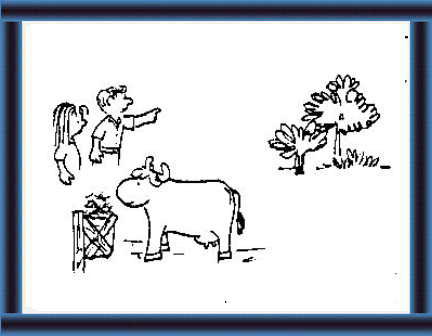 |
What are the advantages of feeding shrub and
tree fodders to your animals? (5-13)
1 They:
|
 |
Are there any disadvantages? (14-16)
2 You should not use more than 30 % of shrub and tree fodders in your feed. |
 |
What suitable varieties of shrubs and trees are
there? (17)
3 See Annex I. |
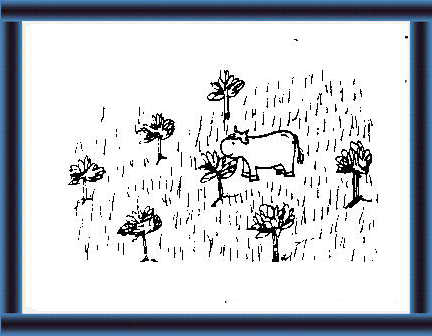 |
How can you establish and manage tree fodders? (18-40) 4 See the examples:
|
| FODDER
FROM SHRUBS AND TREES
Husbandry Unit 5.2: Technical Notes Note: Numbers in brackets refer to illustrations in the Extension Materials. In Asian countries, fodders from trees and shrubs have been used for feeding livestock from ancient times. However, not much work has been done on their management and utilization for feeding dairy cattle and buffalo. With increasing interest in dairy development and competition for the limited land resources available, the potential of shrub and tree fodders in the feeding of dairy cattle and buffalo is being recognized. The advantages of feeding shrub and tree fodders are many. Some of the important ones are: - there are some naturally growing shrubs and trees, fodders from which are already available for many farmers; an understanding of their nutritive value will enable them to be included in the diets of cattle and buffalo; (5) - trees and shrubs can be grown on lands unsuitable for other crops and pastures; (6) - they can be grown in crop areas, spacing them suitably to prevent excessive shade to the crops; (7) - using them as fences and hedges reduces the costs of fencing which is an additional benefit; (8) |
What are the advantages of feeding shrub and tree fodders to your animals?
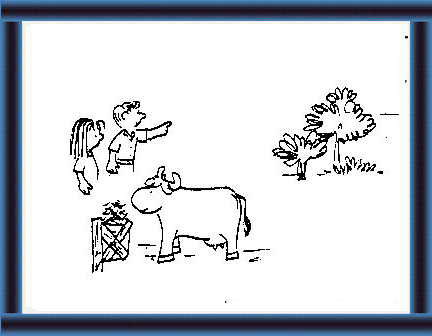 |
5 Some shrubs and trees grow
naturally.
If you know their nutritive value, you can add them to your animals' feed. |
 |
6 You can grow shrubs and trees:
- on land which is not suitable for other crops and pastures |
 |
7
- with other crops. Space them correctly so they do not shade other crops too much |
 |
8
- as hedges and fences. This saves you money.
|
|
- as the root systems penetrate deep into the soil, trees and shrubs can continue to produce foliage over a longer period into the dry season; (9) thus cattle and buffalo can be given a green roughage along with crop residues such as straw, supplemented with concentrates where necessary, during the dry season; (10) - establishment and maintenance are easier and less expensive than the pasture and fodder grasses and they have a long life span reducing the costs of re-establishment; (11) - mature branches can be used
as a source of firewood; (12)
|
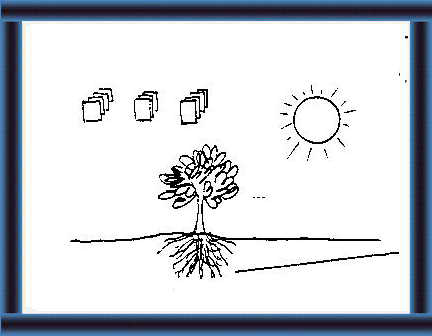 |
9 They produce foliage longer into the dry season because the roots go deep in the soil |
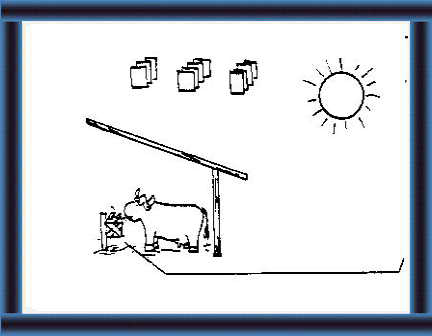 |
10 so you can give your animals a green roughage with crop residues e.g. straw and concentrates (where necessary) in the dry season. |
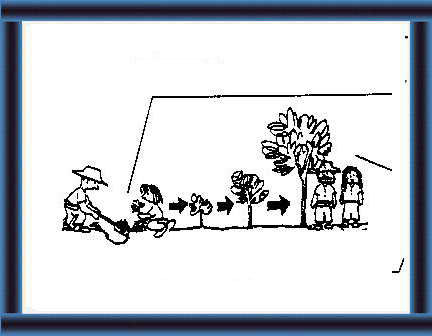 |
11 You can establish and maintain
shrubs and trees more easily than pasture and fodder grasses.
They live a long time so you spend less money on re-establishment. |
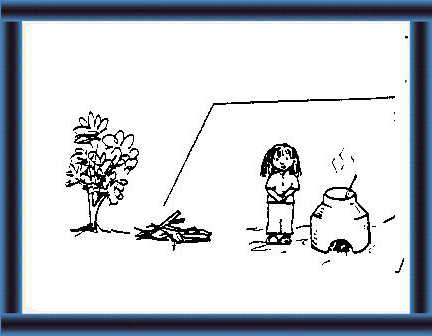 |
12 You can use mature branches
as firewood.
|
|
- when cutting is done manually, which is the practice with smallholders, it is more convenient and less time consuming with shrub and tree fodders than with many varieties of pasture and fodder grasses. (13) The main disadvantage with tree fodders is that some of them have certain toxic compounds. However, these compounds usually occur only in small quantities and their ill-effects would disturb the animals only if they are given as the main (or only) feed over a long period of time. (14) These ill-effects can be overcome by limiting the quantity of tree fodders to about 30% of the total daily feed intake (measured in terms of dry matter). (15) Another disadvantage is that adequate
information on the nutritive value of most of the tree and shrub fodders
is not freely available. This is a problem that must receive the
attention of research institutions and extension officers. Presently
available information shows that fodders from such plants as Leucaena leucocephala
(ipil ipil) and Glyricidia maculata are as nutritious or even more nutritious
than some of the pasture and fodder grasses. (16)
|
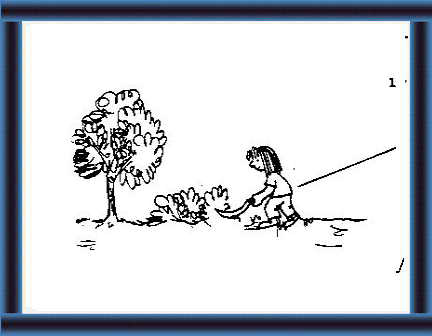 |
13 It is easier and quicker to cut shrubs and trees/fodders by hand than to cut pasture and fodder grasses. |
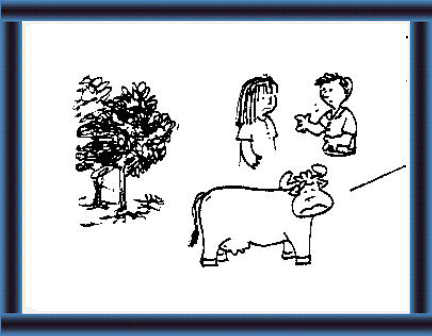 |
Are there any disadvantages?
14 Tree fodders contain small amounts of poisons which are bad for your animals if tree fodders are the only feed for a long time. |
 |
15 Up to 30 % of tree fodder in feed (measured by dry matter) should cause no ill effects. |
 |
16 Ask your extension worker for information
(though sometimes there is none for shrub and tree fodders).
|
|
Suitable varieties There are several varieties of fodder trees and shrubs which can be grown under different agro-climatic conditions. They are classified in the Annex. (17) Establishment and management of tree fodders Tree and shrub fodders can be propagated vegetatively or by seeds depending on the species. Two examples are given below, one for propagation by seeds and the other by stems as well as seeds. Example 1 Leucaena leucocephala: There are many varieties of this species. Different varieties are being recommended in different countries. Even though many Leucaena plantations were destroyed by an insect during the mid 1980's, resistant varieties have now emerged. Leucaena does not grow well in water-logged areas and acidic soils. In acidic soils, acidity has to be reduced by the addition of Lime or Dolomite. Addition of Superphosphate will facilitate the initial establishment. (18) Propagation is by seeds. - Seeds have to be soaked in boiling water for about a minute before planting to damage the hard seed coat. (19) - Seeds are allowed to cool and
then mixed with inoculum. Inoculum can also be added to the seed
bed in the form of a solution, after the seeds have started to germinate.
(20,22)
|
 |
What suitable varieties of shrubs and trees are
there?
17 See the list in the Annex for different local conditions. |
 |
19 Soak the seeds in boiling water for 1 minute to damage the hard seed coat. |
 |
20 Cool the seeds and mix with inoculum.
|
| - Seeds can be planted
directly in the soil; to avoid being attacked by rabbits, monkeys etc.
repellents such as diluted fresh animal urine may be poured on the plants.
(21)
- Another method is to plant the seeds in a nursery: e.g. small polythene bags containing a mixture of soil and compost (with an extra amount of Superphosphate, where necessary). Plant two seeds in each bag. (23-24) |
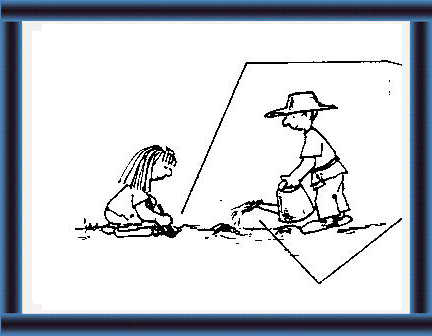 |
21 Plant the seeds directly in the soil.
Apply e.g. animal urine mixed with water to keep
rabbits, monkeys etc. away.
|
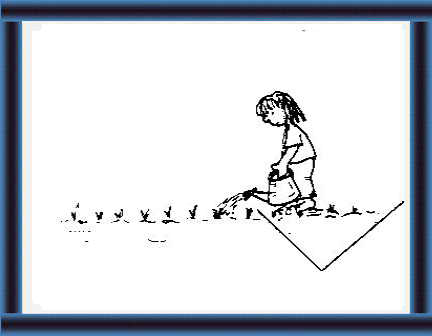 |
22 When the seeds begin to grow, you can apply a solution of inoculum. |
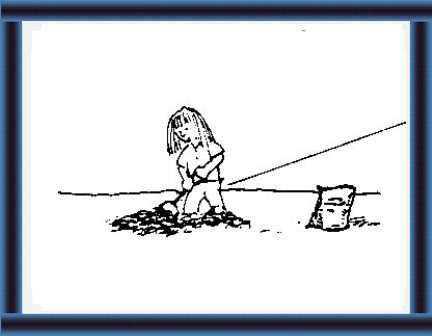 |
23 You can plant the seeds in a nursery:
- mix soil with compost (and Superphosphate if necessary)
|
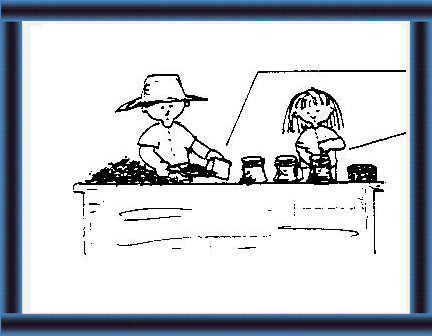 |
24
- fill small polythene bags with soil mixture - plant 2 seeds in each bag.
|
|
- Transfer to the soil at planting time is easy but it is difficult to transport over long distances. (25) - Another method is to add a layer of soil (and compost) about 15 cm thick over polythene spread on firm ground and to plant the seeds on this seed bed. (26) - The seedlings are uprooted at planting time and all the leaves are pulled off by hand before transplanting in holes made with an iron bar. (27) Space allowed between plants depends on where they are planted. - If planted to serve as a fence,
the spacing can be about 6 cm. Two or three rows planted at a distance
of about 6 cm from each and maintaining the same space between plants makes
a beautiful hedge. (28)
|
 |
25 When the seedlings are 20-40 cm. tall,
move them to the field.
This method can be difficult if the field is far
away.
|
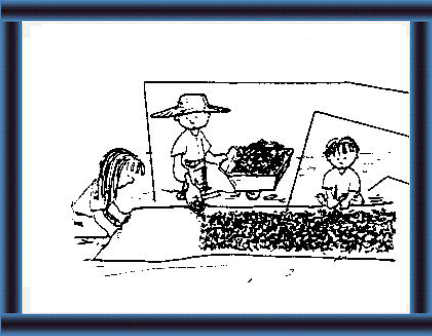 |
26 You can also:
- spread a polythene sheet on firm ground - add a 15 cm layer of soil/compost - plant the seeds on this seedbed
|
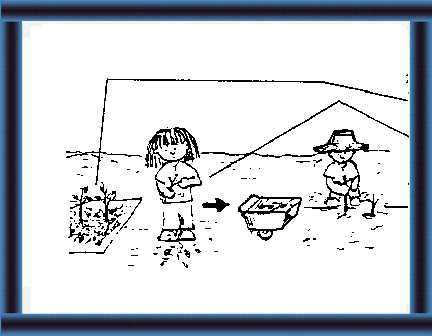 |
27
- uproot the seedlings at planting time - pull all the leaves off by hand - plant in the field in holes made with an iron
bar.
|
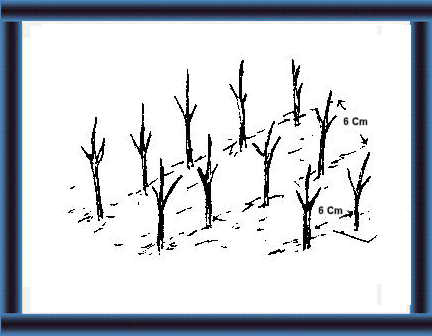 |
28 For fences:
- plant 2 or 3 rows 6 cm apart - each plant 6 cm apart in the row to make a beautiful
hedge.
|
|
- Such hedges can be grown at a distance of 2-3 m on open pastures or as a component in an integrated farm-ing system. (29) - They may also be grown as individual plants in an open pasture at spacings of 2 x 2 m; animals may be allowed to graze these plants with the pasture when they are about a metre high. (30) - Alternatively, the plants may be allowed to grow to maturity beyond the reach of animals and the animals allowed to graze the new seedlings that sprout from the seeds falling onto the ground. (31) - Leucaena plants can be grazed when they are about a metre tall. When they are cut to be used as a fodder, the plants may grow up to a height of about 1.5 to 2 m. - Grazing or lopping
is usually done at 2-3 month intervals. When lopping,
it is good practice to leave a few small branches to facilitate regrowth.
(32)
|
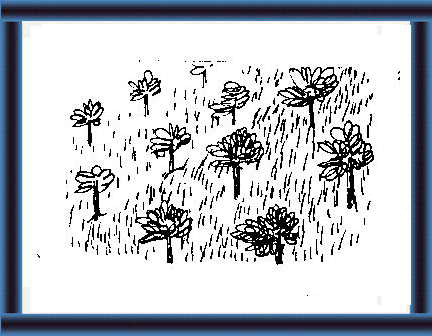 |
29 You can grow hedges at 2-3 m spacing
on open pastures or as part of an integrated farming system.
(See H 1.1) |
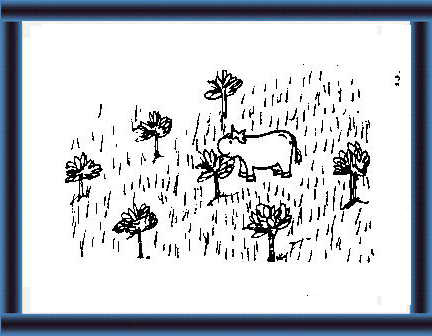 |
30 You can grow plants at 2 m spacing in open
pasture.
Your animals can graze on the pasture and these
plants when they are about 1 m high
|
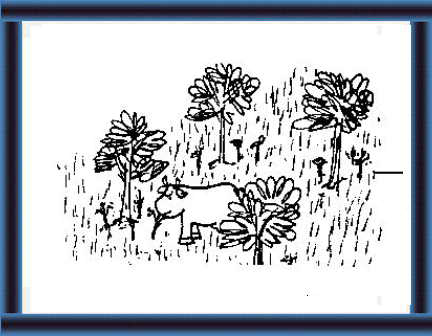 |
31 or you can let the trees grow to full height and your animals can eat the seedlings from seeds on the ground. |
 |
32 Lop trees for fodder when they are about 1.5-2
m tall.
Leave a few branches for good regrowth. Graze or lop every 2-3 months.
|
|
- If adequate space is allowed between plants, e.g. when grown as separate plants or in a single row fence, each tree may give a yield of about 3-5 kg per lopping. The yield is lower during periods of drought. 90-100 trees will provide about 5 kg of leaves per day on average, throughout the year, if managed well. (33) Example 2 Glyricidia maculata: This species grows in a wide variety of agroclimatic regions and can thrive on many different types of soil. It has adapted well under adverse climatic conditions and shows a high degree of resistance to pests and diseases. Glyricidia is used as a shade tree in tea and coffee plantations and as a support and shade in pepper plantations. (34) Propagation can be by seeds or
stems. To prevent the planted stems being disturbed by cattle and
buffalo, 1.5 m long stems can be planted along fences. The stems
are planted in holes made by an iron bar. No other land preparation
is usually necessary for planting stems. Spacing between plants varies
depending on where they are planted: (35)
|
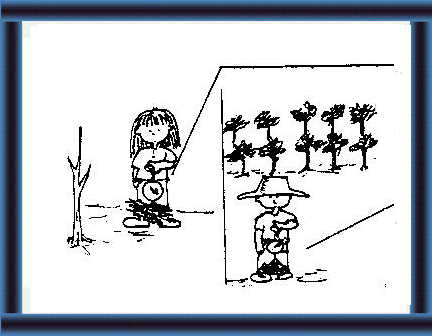 |
33 With enough space, each tree gives about 3-5
kg per lopping (less in dry periods).
90-100 well managed trees give about 5 kg leaves
per day for the whole year.
|
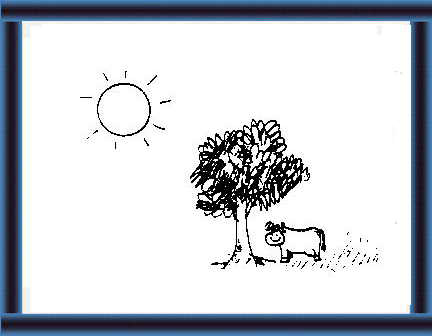 |
Glyricidia maculata by seed or stem propagation
34 This tree grows under many conditions and resists pests and diseases. Farmers often use it for shade. |
 |
35 Plant 1.5 m stems along fences
to protect from your animals.
Use an iron bar to make holes.
|
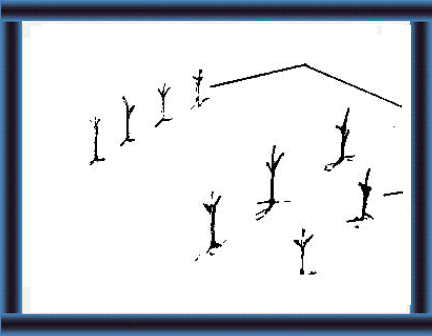 |
36 Spacing is usually:
- 15-30 cm in a single row fence - 60 cm between plants and rows in a double row
fence
|
|
- if planted individually among other crops, spacing is 5 x 5 metres. (37) Lopping of branches is done once in about 2-3 months. The plants should not be allowed to grow to a height of more than 2.0 m. A single tree may bear about 10-15 branches at a time. (38) When lopping, about 25 % of the branches are allowed to remain intact, to facilitate further growth. The harvest at one lopping is about 7-9 kg per tree. (39) Addition of cow dung and compost
increases the yield. It has been estimated that the yield from about
175-200 well managed trees would be sufficient to supply the roughage requirement
of a cow throughout the year, when mixed with chopped rice straw.
A fence of about 60 m length will have this number of trees.
(40)
|
 |
37
- 5 x 5 m for individual plants among other crops.
|
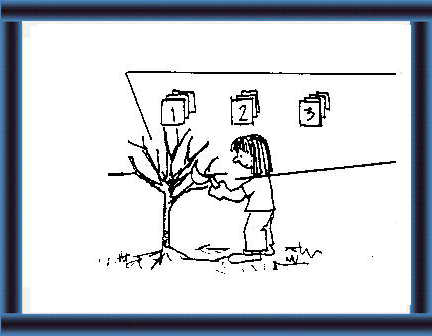 |
38 A tree can bear 10-15 branches at one time.
Lop every 2-3 months and do not allow to grow
taller than 2.0 m.
|
 |
39 Leave 25% of branches for good regrowth.
You should get 7-9 kg branches from each tree.
|
 |
40 Apply cow dung and compost for higher yields.
175-200 well-managed trees (a fence of 60 m) gives
enough roughage for 1 cow for 1 year when mixed with chopped rice straw.
|
|
|